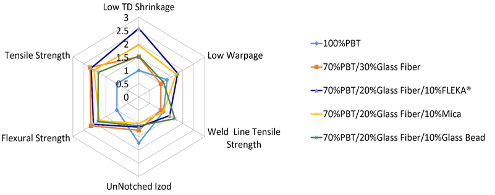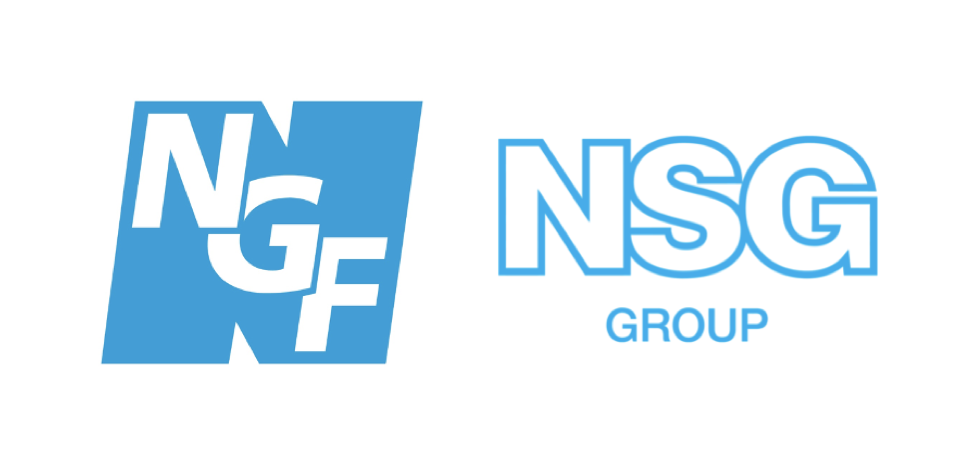Glass-Reinforced Plastics: How Glass Flakes Could be a Game-Changing Additive
NGF
Modern-day industries involve application areas that essentially require materials with a demanding combination of properties, especially those of strength, thermal shock resistance, dimensional stability, and aesthetics. From bridges and wind turbines to automotive paints and cosmetics, the need for specified, economical materials that can meet the diverse requirements is at a record high due to the variety of uses. One proven material that has been provided as an effective solution for numerous such applications is glass-reinforced plastics (GRPs). At an annual growing production volume reaching up to 1.14 million metric tons in 2019, the extent by which GRPs are used is substantial. Introduced in the 1960s, one of the major and most common glass reinforcements is glass flakes. So, what are GRPs exactly? How are glass flakes used as reinforcements? And what makes them unique and almost irreplaceable?
Glass materials have been in usage for millennia due to their unique properties, accessibility, attractive aesthetics, and cost-effectiveness. But in the early 20th century, a new use of glass was discovered in the form of reinforcements for polymers. This ground-breaking discovery combined the unique properties of glass with the functional properties of polymers to fabricate material products with excellent features, known as glass-reinforced plastics.
GRPs are composite materials made of a synthetic resin (polymer) matrix reinforced with glass fibres, glass beads, or glass flakes. These three main forms of glass reinforcements provide different possibilities of usage as they result in material properties required by distinct application areas. These application areas include construction, renewable energy equipment, automotive industry, commercial products, cosmetics, and electronic packaging.
Glass manufacturing, nowadays, follows the process steps of glass formulation, procurement of raw materials, and melting the materials in large refractory furnaces to be formed later into distinct configurations, such as sheets, beads, fibres, and flakes.
Borosilicate glass, for example, is one of the tougher types of glass as it is made of silica and boron trioxide. It is a distinct material because while it can be processed just like any other glass formulation, its use in the form of fibre, bead, or flake shows its capacity to be an excellent reinforcing material. With a significantly low thermal expansion coefficient (~3×10−6 K−1 at 20°C), borosilicate glass can outshine any other type of glass in terms of thermal shock resistance.

Figure 1. Coating automotive paint with glass flakes results in a unique metallic lustre.
Glass flakes as reinforcements
Introduced in the late 1950s and early 60s, glass flakes were initially used to reinforce polyester-based roof-light panels in the United States. The glass flakes addition showed great potential as they provided a substantial improvement in dimensional stability and light transmission, outperforming glass fibres at the time, which suffered from reduced light transmission and unwanted light shielding. It was not too long until glass flakes were incorporated into protective coatings formulations, which remained the most common usage of glass flakes for years.
Today, the range of glass flake uses has expanded considerably, reaching many established industrial and commercial applications. Glass flakes can be utilised as effects pigments in automotive paint, plastics, and cosmetics, revealing attractive visual effects such as glitter, lustre, pearl, and metallic looks. As a functional additive, they are also used in plastics, where they provide strength and isotropic dimensional stability to plastic end products, minimising warpage risks and dimensional expansion. In addition to that, glass flakes remain an effective factor in infrastructural protective coatings, as they offer outstanding wear resistance and tortuous barrier properties.

Figure 2. Infrastructural protective coatings with glass flakes can result in excellent wear resistance.
By definition, glass flakes are exceptionally thin plates of borosilicate glass. They are manufactured in two different processes, called the bubble method and the spinning cup method, under precise manufacturing controls that ensure consistent flake dimensions. Those dimensions follow a defined particle size distribution (PSD) based on distinct specifications. Typical thickness and diameter values of glass flakes can be seen in Table 1 below. Finished products are based on combinations of average diameters and thicknesses.
Table 1. Typical dimensions of glass flakes (provided by NGF)
|
Average Diameter (in µm) |
Thickness (in µm) |
|
18, 20, 25, 30, 40, 80, 120, 160, 240, 300, 480, 600 |
0.7, 1, 2, 5 |
One unique example of glass flake materials is FLEKA® by NGF of the NSG Group. At 10-30% weight basis loading, FLEKA® provides a significant enhancement to the base polymer performance, eliminating the need for a compromise between strength and dimensional stability. It improves the material’s resistance to wear, abrasion, impact, and warpage. With its isotropic, random orientation, reinforcement is evenly distributed in both the machine direction (MD) and transverse direction (TD), resulting in better dimensional stability.
Generally, glass flakes are preferred to be in granular form when bought. Distinctively, NSG can provide granular glass flakes by adding a temporary binder to the flakes during their final manufacturing stage. Evidently, granulated glass flakes can be handled much more easily, with granule’s average diameters ranging between 0.5- and 1.0-mm. The FLEKA® granule would simply disintegrate back to the initial glass flake sizes as it reaches the screw extruder.

Figure 3. SEM images of granular FLEKA® (left) and Microglass (right) glass flakes. (NGF)
What makes glass flakes unique?
Just like glass flakes, many glass forms can be used as additives. However, most of them involve trade-offs in performance. Here is where glass flakes, such as FLEKA®, are able to stand out. Table 2 shows a comparison between different glass additives in terms of their mechanical and dimensional performance.
Table 2. Comparison between glass-based additives in terms of performance trade-offs
|
Additive |
Mechanical properties |
Dimensional Stability |
|
Glass Fibre |
✓✓ |
- |
|
Mica |
- |
✓ |
|
Glass Bead |
- |
✓ |
|
FLEKA® Glass Flake |
✓ |
✓✓ |
While glass fibres provide outstanding impact resistance properties, they suffer from differential shrinkage, resulting in part warpage. In a similar sense, the use of mica and glass beads includes the compromise of high mechanical properties. Glass flakes, on the other hand, are able to enhance both requirements with almost no trade-off due to their unique particle aspect ratio and random orientation within the base polymer.
One study performed by Interfacial Consultants (IFC) that compared the physical properties of additives in natural polybutylene terephthalate (PBT) validated this claim. The results showed that the addition of FLEKA® lowered the shrinkage and warpage percentages and offered improved dimensional stability and enhanced mechanical properties. The key conclusion of the study was that combining FLEKA® with glass fibre offered the best balance of properties between warpage, weld line strength, and mechanical properties.

Figure 4. Performance comparison of additives for plastic (IFC)
Where to find glass flakes?
As glass-based composites are becoming more effective and widely required, engineers, product designers, and formulators must be able to easily find additive materials like glass flakes and compare them with other materials. Global suppliers NGF are at the vanguard of design, manufacture, and marketing of specialised glass cord and glass flake products, and they have listed their unique glass flake materials and many more here on Matmatch.
Visit the NGF supplier page for more information on their materials listed on Matmatch and to get in direct contact with them.
Article by NGF
NGF is a global business with manufacturing units in Japan, China, UK, Poland and Canada and is a member of the NSG Group of companies. The group is a world leader in the manufacture of glass products for building, automotive and information electronics applications.
NGF is at the forefront of the design, manufacture and marketing of specialised glass cord and flake products that are used in a variety of industries worldwide.
- MICROGLAS ® CORD provides enhanced adhesion to rubbers or thermoplastics through a special surface treatment applied to continuous glass fiber. Because of its superior properties, such as tensile strength, flexural fatigue resistance, dimensional stability, and heat resistance, MICROGLAS ® CORD is used as a reinforcing member in a variety of elastomeric applications such as; timing belts for automobiles; power transmission belts for various industries; extruded rubber profiles; high-performance tires; and other mechanical rubber goods. Cord can also be chopped to various lengths and used for compound reinforcement. Carbon Fibre, Aramid and Hybrid cords are also part of the company’s portfolio.
- HIGH TENSILE GLASS YARN (HTY) comes with different tensile strengths, diameters and treatments, with increased modulus and strength per weight when compared to E glass yarns. It can be woven or used unidirectional and pre-impregnated with liquid resin to form a semi-cured product. These are the basis for lightweight high strength construction parts. These components can be used in technical fabrics in mid to high temp insulation applications; ballistic protection; lightweight reinforcement for aerospace; defence and civil applications.
- GLASFLAKE ® is manufactured from glass flakes available in C-, E- or TA- chemistries and whose average diameter ranges from 10 μm to 4,000 μm (4 mm) in size having 2 μm or 5 μm low-tolerance thickness. C-glass flakes are exceptionally acid-resistant. When applied as a liquid coating, these glass flake additives produce a "tortuous barrier effect" and dramatically improve protective service life and chemical resistance, increase wear resistance, prevent the coating from cracking and allow contractors to double their wet-film thickness. Because of their unique dimensions and aspect ratio, E-glass flakes can prevent warpage or shrinkage and thereby provide dimensional stability for moulded or extruded thermoplastic or thermoset products. TA- glass delivers ultra-low heavy metals contents to the cosmetics industry.
- METASHINE ® is an effects pigment that starts with NSG glass flake substrates upon which a range of pure metal or metal oxide coatings are precisely applied. Because the glass flakes are transparent and extremely smooth, there is no reduction of the aesthetic properties of the base materials. METASHINE is widely used in a variety of applications including automotive paints (OEM and refinish), electric and gas appliance surfaces, plastics, inks, and cosmetics to produce outstanding glitter, sparkle or unique metallic luster effect.

